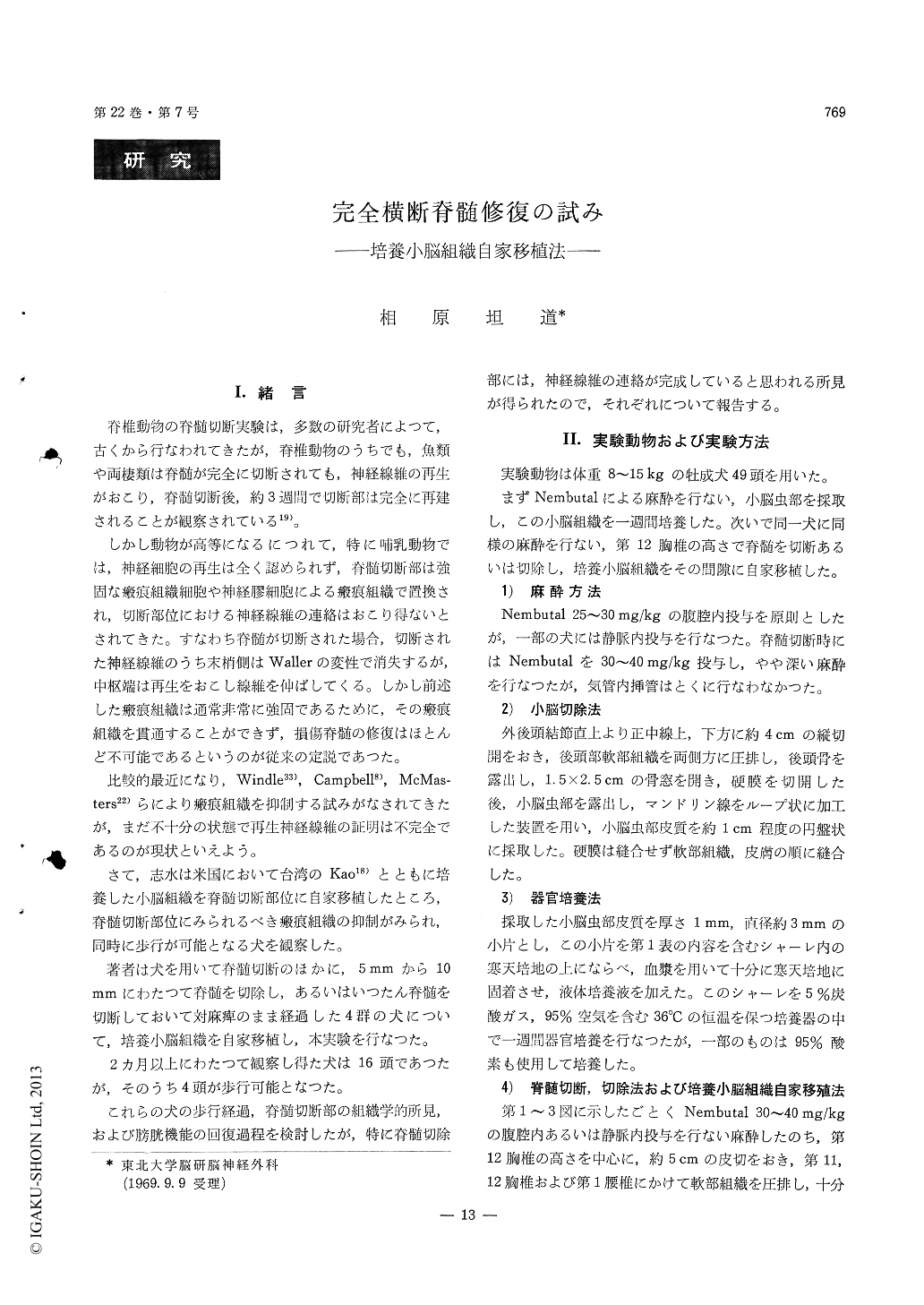Japanese
English
- 有料閲覧
- Abstract 文献概要
- 1ページ目 Look Inside
I.緒言
脊椎動物の脊髄切断実験は,多数の研究者によつて,古くから行なわれてきたが,脊椎動物のうちでも,魚類や両棲類は脊髄が完全に切断されても,神経線維の再生がおこり,脊髄切断後,約3週間で切断部は完全に再建されることが観察されている19)。
しかし動物が高等になるにつれて,特に哺乳動物では,神経細胞の再生は全く認められず,脊髄切断部は強固な瘢痕組織細胞や神経膠細胞による瘢痕組織で置換され,切断部位における神経線維の連絡はおこり得ないとされてきた。すなわち脊髄が切断された場合,切断された神経線維のうち末梢側はWallerの変性で消失するが,中枢端は再生をおこし線維を伸ばしてくる。しかし前述した瘢痕組織は通常非常に強固であるために,その瘢痕組織を貫通することができず,損傷脊髄の修復はほとんど不可能であるというのが従来の定説であつた。
Reconstruction of the injured spinal cord has long been an interesting problem to many investigators and they have tried to reconstruct the damaged spinal cord.
If the spinal cord is transected, the gap of the severed cord was used to be filled with the thick collagenous scar up to now and regenerating nerve fibers could not pass through this scar tissue.
The cultured cerebellar cortex was transplanted into the gap of the severed spinal cord in order to protect the scar which grow up in the gap of the severed cord.
Fourtynine female adult dogs were used in this study. After suboccipital craniectomy, a portion of the cerebellar cortex was removed.
The removed cerebellar cortex was cultured in a CO2 Incubator at 37°C for a week prior to autotransplantation.
After spinal cord was cut or resected from 5 cm to 10 mm in length at the Th-12 level, the cerebellar cortex was transplanted into a gap of the spinal cord.
Sixteen among fourty nine dogs could follow up for more than two months after operation. Four dogsof them recovered the functions of the spinal cord about three months after operation.
The cystometrogram was recorded in order to probe the regeneration of axon in the spinal cord., Four dogs which could walk after operation showed almost normal cystometrogram.
On the other hand, another dogs which were completely paraplegic after operation showed abnormal cystometrogram which revealed no micturition and urinary incontinence.
Modified Bodian stain was performed for microscopic examination.
Three among four dogs which could walk after operation revealed exactly the regenerating nerve fibers in the gap of the spinal cord.
Especially, for one dog which was paraplegic for nine months after spinal cord transection, the transplantation of the cultured cerebellar cortex was performed secondary with 7 mm scar excision which grew up after first operation. Three months after operation, it became to be able to walk, and seven months after opertion, it was dissected for microscopic examination.
The site of the gap at the spinal cord was narrowed by invading scar, but the regenerating nerve fibers were found and the connections between the both end of the severed spinal cord were detected.
The other dog which could walk two months after operation, however, became awkward five months after operation and became to be unable to walk six months after operation terminaly. As a results of its autopsy, it revealed that the gap of the spinal cord was filled with collagenous scar, and regenerating nerve fibers could not be found.
On a few of them in which did not recover the functions of the spinal cord, a little nerve fibers could be found in the invaded scar tissue. These nerve fibers was suspected, the socalled, abortive regenerating nerve fibers what Cajal said.
From now, this study will be continued to establish as the operative method for human spinal cord injury.

Copyright © 1970, Igaku-Shoin Ltd. All rights reserved.


